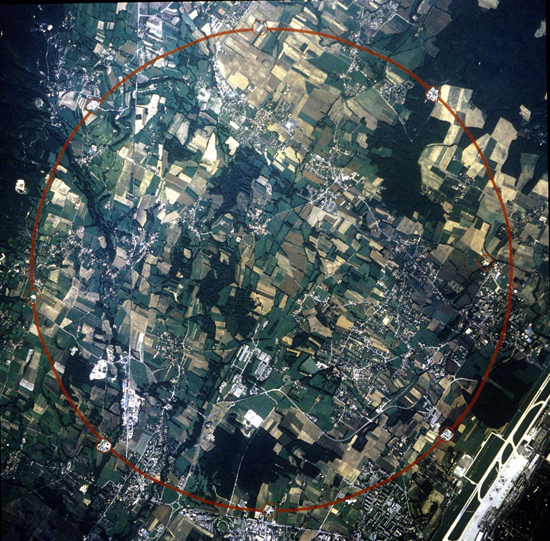No collisions and no beams either next week at the Large Hadron Collider (LHC). The BBC reported a quench of about 100 superconducting magnets yesterday that heated up as much as 100 Celsius. A ton of liquid helium spilled into the tunnel and the CERN fire brigade went in. Cause of the quenching has not been announced, nor have any injuries been reported.
The fault does not pose any longer-term threat to the LHC. The quench occurred during final testing of the last of the LHC's electrical circuits. Liquid helium leaks vaporize back to a gas almost instantly and would freeze or choke personnel present but no workers were at risk, according to CERN, the European Organization for Nuclear Research, which runs the LHC.Ordinarily magnet quenches occur when part of the superconducting coil enters a 'normal' state, either the field inside the magnet is too great, eddy currents occur or, more rarely, because of a defect in the magnet. CERN's press statement states "the most likely cause of the problem was a faulty electrical connection between two magnets, which probably melted at high current leading to mechanical failure."
If beams had been running, they would have been at their lowest power, 0.45 TeV per beam, though beams 11 times more powerful at 5 TeV were scheduled before October 12th. Vacuum conditions were also lost said the BBC, citing LHC's online logbook.This is on top of news that a thunderstorm burned out a giant 30-ton 12 Million Volt Amperes surface transformer that powers some of the helium cryogenics system, a problem CERN admitted on September 18th, without mentioning the thunderstorm, and said the transformer was replaced last weekend. The failure of the transformer caused an initial warming in the helium coolant in 2 of the colliders 8 sectors, some magnets as late as September 17th at near 7 K.
The TimesOnline initial report on damage said, "One of the beams had been captured by Friday, but work was then interrupted by the loss of electrical transformers that power the cryogenic cooling system . . ." A beam was apparently running during the thunderstorm, though it seems the beam was stored before the giant transformer failed, but perhaps more than one transformer lost in this early account. CERN's lastest progress report of Sept 18th was sketchy.
The damaged Sector3-4, an eighth of the 17 mile collider has still not been stabilized since yesterday morning's accident. About half of it or a mile length was well above normal 1.9 K design temperature, about a quarter of the sector and its magnets yesterday afternoon at 15:46 PM were about 82 K to 110 K. Currently all magnets have warmed. The warmest show a slight recovery from 110 K down to 99 K. and Sector 3-4 is still in crisis as of the 20th September 0:418 AM, with no accurate readout for about half the magnets, and the rest showing more warming, with a few outside the spike zone climbing abruptly in temperature since yesterday afternoon.
Given the nature of the accident, repairs could take a week or longer. At Fermilab's Tevatron, a quench took 2 weeks to repair and get the collider up to speed again. The damaged LHC ring Sector 3-4 is considered to be equivalent to the Tevatron's ring size, overall like 8 Tevatrons.
For a comparison of Cooldown Status Graphs mentioned above from the accident yesterday, see Accident Forces Two-Month Delay At The Large Hadron Collider (LHC).
NOTES:
Higgins, Alexander G. "CERN: Damage to new collider forces 2-month halt", Sept 20, 2008, AP News on NewsTimes, http://hosted.ap.org/dynamic/stories/E/EU_SWITZERLAND_PARTICLE_COLLIDER?SITE=CTDAN&SECTION=HOME&TEMPLATE=DEFAULT
BBC. "Hadron Collider forced to halt", Sept 19, 2008, BBC News, http://news.bbc.co.uk/1/hi/sci/tech/7626256.stm
CERN. "LHC progress report, week 1", Sept 18, 2008, LHC First Beam, http://lhc-first-beam.web.cern.ch/lhc-first-beam/News/lhc_080918.html
Henderson, Mark. "'Big Bang Machine' back on collision course after its glitches are fixed", Sept 18, 2008, TimesOnline, http://www.timesonline.co.uk/tol/news/uk/science/article4774817.ece





Comments